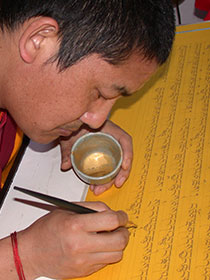- Home
- FPMT Homepage
Foundation for the Preservation of the Mahayana Tradition
The FPMT is an organization devoted to preserving and spreading Mahayana Buddhism worldwide by creating opportunities to listen, reflect, meditate, practice and actualize the unmistaken teachings of the Buddha and based on that experience spreading the Dharma to sentient beings. We provide integrated education through which people’s minds and hearts can be transformed into their highest potential for the benefit of others, inspired by an attitude of universal responsibility and service. We are committed to creating harmonious environments and helping all beings develop their full potential of infinite wisdom and compassion. Our organization is based on the Buddhist tradition of Lama Tsongkhapa of Tibet as taught to us by our founders Lama Thubten Yeshe and Lama Thubten Zopa Rinpoche.
- Willkommen
Die Stiftung zur Erhaltung der Mahayana Tradition (FPMT) ist eine Organisation, die sich weltweit für die Erhaltung und Verbreitung des Mahayana-Buddhismus einsetzt, indem sie Möglichkeiten schafft, den makellosen Lehren des Buddha zuzuhören, über sie zur reflektieren und zu meditieren und auf der Grundlage dieser Erfahrung das Dharma unter den Lebewesen zu verbreiten.
Wir bieten integrierte Schulungswege an, durch denen der Geist und das Herz der Menschen in ihr höchstes Potential verwandelt werden zum Wohl der anderen – inspiriert durch eine Haltung der universellen Verantwortung und dem Wunsch zu dienen. Wir haben uns verpflichtet, harmonische Umgebungen zu schaffen und allen Wesen zu helfen, ihr volles Potenzial unendlicher Weisheit und grenzenlosen Mitgefühls zu verwirklichen.
Unsere Organisation basiert auf der buddhistischen Tradition von Lama Tsongkhapa von Tibet, so wie sie uns von unseren Gründern Lama Thubten Yeshe und Lama Thubten Zopa Rinpoche gelehrt wird.
- Bienvenidos
La Fundación para la preservación de la tradición Mahayana (FPMT) es una organización que se dedica a preservar y difundir el budismo Mahayana en todo el mundo, creando oportunidades para escuchar, reflexionar, meditar, practicar y actualizar las enseñanzas inconfundibles de Buda y en base a esa experiencia difundir el Dharma a los seres.
Proporcionamos una educación integrada a través de la cual las mentes y los corazones de las personas se pueden transformar en su mayor potencial para el beneficio de los demás, inspirados por una actitud de responsabilidad y servicio universales. Estamos comprometidos a crear ambientes armoniosos y ayudar a todos los seres a desarrollar todo su potencial de infinita sabiduría y compasión.
Nuestra organización se basa en la tradición budista de Lama Tsongkhapa del Tíbet como nos lo enseñaron nuestros fundadores Lama Thubten Yeshe y Lama Zopa Rinpoche.
A continuación puede ver una lista de los centros y sus páginas web en su lengua preferida.
- Bienvenue
L’organisation de la FPMT a pour vocation la préservation et la diffusion du bouddhisme du mahayana dans le monde entier. Elle offre l’opportunité d’écouter, de réfléchir, de méditer, de pratiquer et de réaliser les enseignements excellents du Bouddha, pour ensuite transmettre le Dharma à tous les êtres. Nous proposons une formation intégrée grâce à laquelle le cœur et l’esprit de chacun peuvent accomplir leur potentiel le plus élevé pour le bien d’autrui, inspirés par le sens du service et une responsabilité universelle. Nous nous engageons à créer un environnement harmonieux et à aider tous les êtres à épanouir leur potentiel illimité de compassion et de sagesse. Notre organisation s’appuie sur la tradition guéloukpa de Lama Tsongkhapa du Tibet, telle qu’elle a été enseignée par nos fondateurs Lama Thoubtèn Yéshé et Lama Zopa Rinpoché.
Visitez le site de notre Editions Mahayana pour les traductions, conseils et nouvelles du Bureau international en français.
Voici une liste de centres et de leurs sites dans votre langue préférée
- Benvenuto
L’FPMT è un organizzazione il cui scopo è preservare e diffondere il Buddhismo Mahayana nel mondo, creando occasioni di ascolto, riflessione, meditazione e pratica dei perfetti insegnamenti del Buddha, al fine di attualizzare e diffondere il Dharma fra tutti gli esseri senzienti.
Offriamo un’educazione integrata, che può trasformare la mente e i cuori delle persone nel loro massimo potenziale, per il beneficio di tutti gli esseri, ispirati da un’attitudine di responsabilità universale e di servizio.
Il nostro obiettivo è quello di creare contesti armoniosi e aiutare tutti gli esseri a sviluppare in modo completo le proprie potenzialità di infinita saggezza e compassione.
La nostra organizzazione si basa sulla tradizione buddhista di Lama Tsongkhapa del Tibet, così come ci è stata insegnata dai nostri fondatori Lama Thubten Yeshe e Lama Zopa Rinpoche.
Di seguito potete trovare un elenco dei centri e dei loro siti nella lingua da voi prescelta.
- 欢迎 / 歡迎
简体中文
“护持大乘法脉基金会”( 英文简称:FPMT。全名:Foundation for the Preservation of the Mahayana Tradition) 是一个致力于护持和弘扬大乘佛法的国际佛教组织。我们提供听闻,思维,禅修,修行和实证佛陀无误教法的机会,以便让一切众生都能够享受佛法的指引和滋润。
我们全力创造和谐融洽的环境, 为人们提供解行并重的完整佛法教育,以便启发内在的环宇悲心及责任心,并开发内心所蕴藏的巨大潜能 — 无限的智慧与悲心 — 以便利益和服务一切有情。
FPMT的创办人是图腾耶喜喇嘛和喇嘛梭巴仁波切。我们所修习的是由两位上师所教导的,西藏喀巴大师的佛法传承。
繁體中文
護持大乘法脈基金會”( 英文簡稱:FPMT。全名:Found
ation for the Preservation of the Mahayana Tradition ) 是一個致力於護持和弘揚大乘佛法的國際佛教組織。我們提供聽聞, 思維,禪修,修行和實證佛陀無誤教法的機會,以便讓一切眾生都能 夠享受佛法的指引和滋潤。 我們全力創造和諧融洽的環境,
為人們提供解行並重的完整佛法教育,以便啟發內在的環宇悲心及責 任心,並開發內心所蘊藏的巨大潛能 — 無限的智慧與悲心 – – 以便利益和服務一切有情。 FPMT的創辦人是圖騰耶喜喇嘛和喇嘛梭巴仁波切。
我們所修習的是由兩位上師所教導的,西藏喀巴大師的佛法傳承。 察看道场信息:
- FPMT Homepage
- News/Media
-
- Study & Practice
-
-
- About FPMT Education Services
- Latest News
- Programs
- New to Buddhism?
- Buddhist Mind Science: Activating Your Potential
- Heart Advice for Death and Dying
- Discovering Buddhism
- Living in the Path
- Exploring Buddhism
- FPMT Basic Program
- FPMT Masters Program
- FPMT In-Depth Meditation Training
- Maitripa College
- Lotsawa Rinchen Zangpo Translator Program
- Universal Education for Compassion & Wisdom
- Online Learning Center
-
- Prayers & Practice Materials
- Overview of Prayers & Practices
- Full Catalogue of Prayers & Practice Materials
- Explore Popular Topics
- Benefiting Animals
- Chenrezig Resources
- Death & Dying Resources
- Lama Chopa (Guru Puja)
- Lama Zopa Rinpoche: Compendium of Precious Instructions
- Lama Zopa Rinpoche: Life Practice Advice
- Lama Zopa Rinpoche Practice Series
- Lamrim Resources
- Mantras
- Prayer Book Updates
- Purification Practices
- Sutras
- Thought Transformation (Lojong)
- Audio Materials
- Dharma Dates - Tibetan Calendar
- Translation Services
- Publishing Services
- Ways to Offer Support
- Prayers & Practice Materials
-
- Teachings and Advice
- Find Teachings and Advice
- Lama Zopa Rinpoche Advice Page
- Lama Zopa Rinpoche: Compendium of Precious Instructions
- Lama Zopa Rinpoche Video Teachings
- ༧སྐྱབས་རྗེ་བཟོད་པ་རིན་པོ་ཆེ་མཆོག་ནས་སྩལ་བའི་བཀའ་སློབ་བརྙན་འཕྲིན།
- Podcasts
- Lama Yeshe Wisdom Archive
- Buddhism FAQ
- Dharma for Young People
- Resources on Holy Objects
- Teachings and Advice
-
-
*If a menu item has a submenu clicking once will expand the menu clicking twice will open the page.
-
-
- Centers
-
- Teachers
-
- Projects
-
-
-
-
*If a menu item has a submenu clicking once will expand the menu clicking twice will open the page.
-
-
- FPMT
-
- Shop
-
-
-
The Foundation Store is FPMT’s online shop and features a vast selection of Buddhist study and practice materials written or recommended by our lineage gurus. These items include homestudy programs, prayers and practices in PDF or eBook format, materials for children, and other resources to support practitioners.
Items displayed in the shop are made available for Dharma practice and educational purposes, and never for the purpose of profiting from their sale. Please read FPMT Foundation Store Policy Regarding Dharma Items for more information.
-
-
15
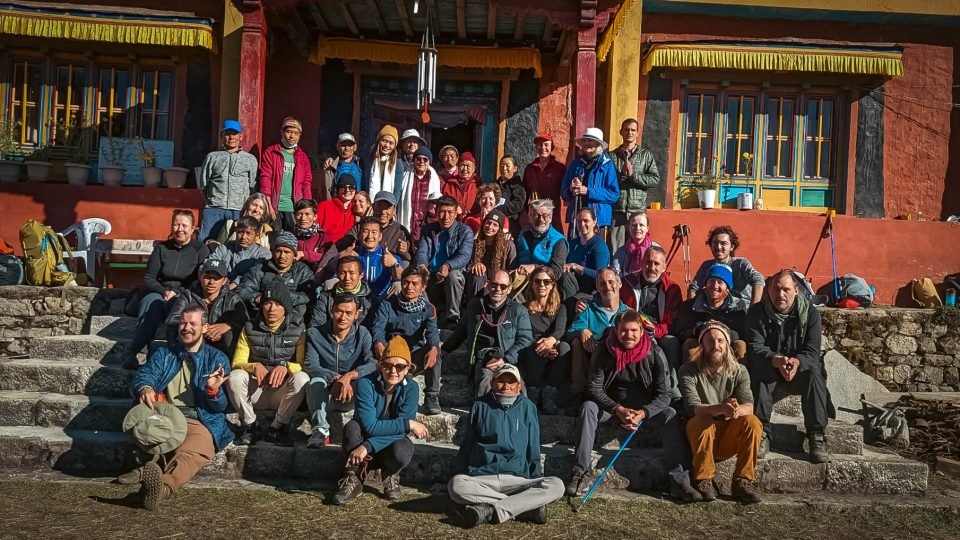
2022 Lawudo trekking group with Lawudo staff, guides, and porters in front of Lawudo Gompa. In the center top is Ven. Robina and Lama Zopa Rinpoche’s sister Ani Ngawang Samten. Photo courtesy of Kristina Mah.
After a two-year hiatus due to the pandemic, the fourth annual Lawudo Trek to Lama Zopa Rinpoche’s cave at Lawudo in Solu Khumbu with Ven. Robina Courtin took place in Nepal’s autumn last year. Twenty-seven pilgrims met on October 3, 2022 at Kopan, Monastery, where Ven. Robina offered four days of teachings. An unusually long monsoon meant they had to change plans and travel in small groups by helicopter from Kathmandu rather than take the plane to Lukla as usual. The pilgrims walked for three days, led by Amber Tamang and his Three Jewels Adventures team, and spent four days in retreat at Lawudo.
Lawudo Trek organizer Kristina Mah shares details of this extraordinary pilgrimage:
As always, our days of teachings from Ven. Robina at Kopan, supported by Ven. Katy leading meditations, set the tone, preparing us for the intensity of the next ten days of trekking up the mountains and retreating at Lawudo. Our group were from Australia, Germany, Great Britain, Italy, Poland, and the USA. Some had been booked since 2019. For Dom, visiting Lawudo was fulfilling a wish he has had since 2015: “I couldn’t believe it was finally happening!”
Bad weather prevented us from leaving for Lukla as scheduled, so we postponed for a day. We thought about taking helicopters instead, which would add at least US$7,000 to our bill. Fortunately a most kind benefactor offered the funds, otherwise we might not have made it to Lawudo at all.
Many of our group had never flown in a helicopter and delighted in the experience, but Jacque, “can vividly remember that first terrifying, ominous helicopter ride. Everyone else was all smiles when we landed but I was just happy to have made it out alive!” Our guides pointed out their villages as we passed the lower mountain villages.
We traveled in small groups to get to the mountains. Nineteen of us found ourselves at Surke (8,316 ft / 2,535 m), a tiny village that was perched 1,066 ft / 325 m under Lukla. We were dropped there by the helicopters, which could not fly further with the heavy cloud cover at higher altitude. Four of us, Yannai, Bec, Katharina, and Geraldine managed to land at Monjo. There, the local monk was so kind and opened the gompa for them to do their own practice. Seven of us had to wait an extra night in Kathmandu before catching our helicopters.
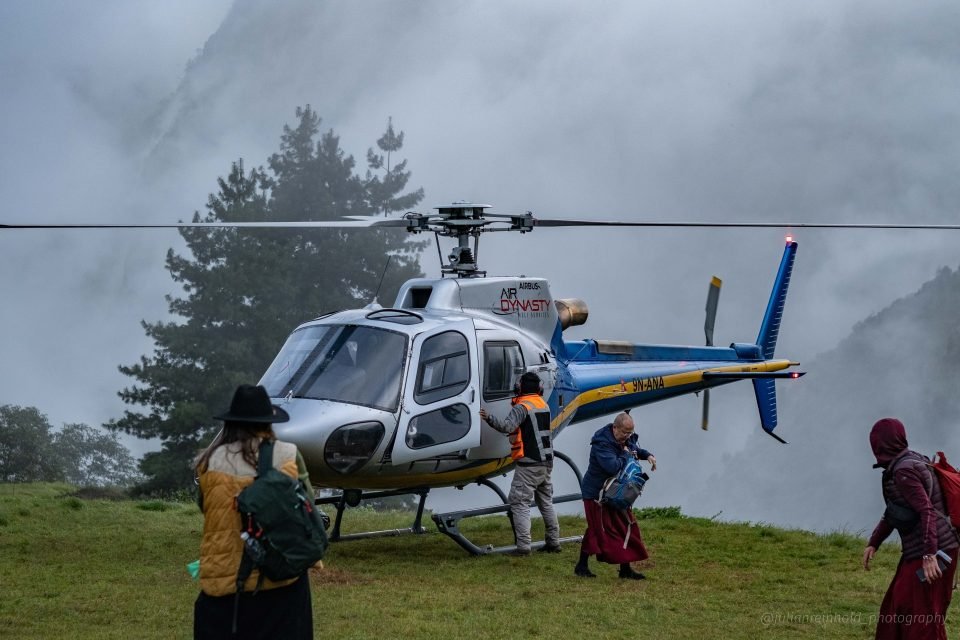
Ven. Robina, Ven. Katy, and Dinae landing at Surke on the way to Namche. Photo Julian Reinhold.
Amber and Furi, the last of our local guiding team, and four trekkers arrived in time for breakfast at Surke. We were thinking about Ven. Robina finally getting her helicopter from Kathmandu all the way to Namche, when just then a helicopter landed on the helipad in the lawn behind the dining room. There was Ven. Robina, and our last group of trekkers, jumping out under the spinning propellers! “What are you all doing at Namche?” Ven. Robina asked, as we greeted her on the lawn. “This is Surke, Venerable,” I replied. “But we’re supposed to be at Namche!” she exclaimed with as much confusion as the rest of us. The pilot flew off without a word!
We took time to have tea and work out our next steps. A larger group of twenty-one trekkers would depart on foot regardless of the weather and a smaller group would wait for the next helicopter out. Ven. Robina brought everyone together for a recitation of the Heart Sutra before we parted ways. Thankfully, the same pilot came back to pick up Ven. Robina, Ven. Katy, Dinae, and Julian. They would arrive at Namche later that day, where we’d all eventually meet for two days to acclimatize before heading to Lawudo.
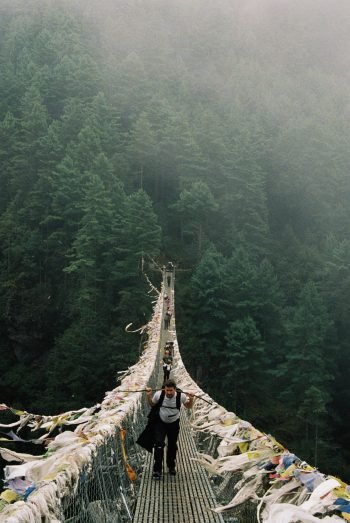
Dom navigating one of the longer
suspension bridges before Namche.
Photo Jacque Rabie.
For our group, the first day of walking was long. It started with a steep climb towards Lukla and we encountered light rain on the track. Everyone was in good spirits and simply happy to be walking after being mostly indoors since meeting at Kopan. “It’s amazing, but harder than I thought it would be,” said Dom. At the pace we were going, it seemed more realistic to aim to arrive at Phakding and stay the night there, at Namaste Lodge. Our porters were already waiting for us in Monjo, the original destination of our helicopters. They walked back to Surke to collect our bags and arrived after dark. We were so grateful.
After dinner, Chammi Tenzing Sherpa, the lodge owner, let us use the sound system when Ven. Robina called to check in on us and sing Tara mantras over WhatsApp in the dining room. To make up some lost time, we would walk all the way to Namche the following day.
We set out from Phakding at 8 a.m., refreshed, and walked purposefully. Our pace picked up with the determination to get to Namche where the others already were. We managed to reach Monjo in great time, at 10 a.m. Mahesh, one of our guides, kindly offered our group tea at his own home on the way.
The walk was beautiful. After leaving the city it was good to be immersed in the different rhythm and energy of Solu Khumbu. Walking the trail, it is common to see trains of donkey or dzo (a hybrid between a yak and a cow) carrying building materials, shopkeepers tending to their stores, children coming and going hand-in-hand, porters with immense loads strapped to their heads, and Nepali music playing out of their tinny phone speakers. Toni took time to find the right words: “The people and life are so… authentic!”
It was the first time we have run the trek in Autumn. Although we caught the end of an unusually long rainy season, it also meant that waterfalls hundreds of meters high were overflowing and rainbows glistened through with sunshine. There were clear views of towering snow-capped peaks. Every few hundred meters, stones and enormous boulders carved and painted with ancient prayers lined the path. Prayer wheels and flags were in abundance, not to mention breathtaking views of valleys and mountains at the top of the world. We witnessed a different way of life, experienced a sensory feast, and at the same time were offered countless opportunities to observe our attachment to comfort and practice non-attachment when things turned out unexpectedly. All of us were reunited at Namche, where we met our full Three Jewels Adventures team. Some of our porters walk for days from their villages to meet us. Amber told us that hundreds of travelers were not able to find flights and were stuck in Kathmandu while our group of twenty-nine people managed to fly and arrive safely at Namche, and we were only one day behind our original schedule. This was amazing.
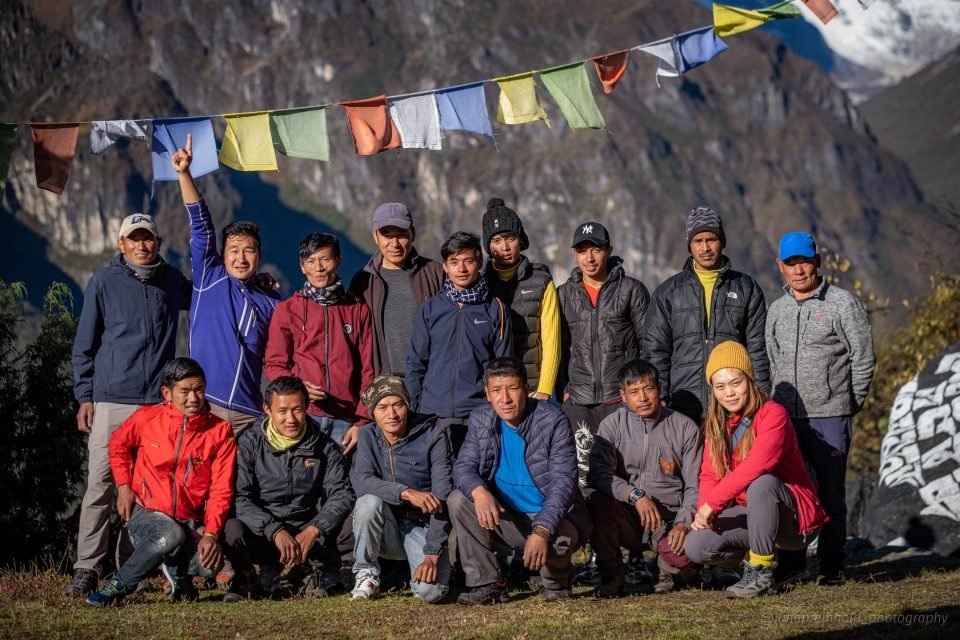
Kristina and Amber Tamang, our lead guide, and his team of guides, porters, and a cook. From top left: Lok, Furi, Chopendre, Amber, Pasang, Nirajan, Abinas, Jeythar. Bottom left to right: Mahesh, Mingmar, Kiran, Furi, Niran, Kristina. Photo Julian Reinhold.
As in previous years, we stayed at Namche for two nights. After staying in small villages, people were dazzled by the bakeries, massage clinics, cafes with great coffee and shops to buy anything you needed in the mountains and more. “It’s the Times Square of the Himalayas!” said Jacque.
Namche Bazaar is a bustling trade and trekking nexus inside Everest (Sagarmāthā) National Park. Trekking parties often stop there before continuing to popular destinations in the region such as Everest Base Camp, Gokyo Lakes, and Island Peak (Imja Tse). Ven. Robina gave us teachings in the beautiful gompa built into Zamling Guesthouse, where we stay every year. She read to us from Lama Yeshe’s Mahamudra: How to Discover Our True Nature, inspiring us and getting us excited about our retreat at Lawudo. The morning sun streamed through the windows as she began reading, “It is extremely difficult to knock out the ego. You cannot seek the ego’s projections philosophically, with your intellect. When you practice mahamudra, intellect is the enemy. You have to go beyond the intellect—you have to meditate. Then real transformation can come.” She looked up from her iPad, “It sounds very tasty, doesn’t it?” We were hooked.
While we were at Namche, Dawn became unwell. The treatment for Dengue was pain relief, hydration, and rest, so it was decided that she stay put. We made sure she was as comfortable as possible, and Mingmar, one of Amber’s team, and our friends at Zamling Guesthouse took care of her for the next five days. She was in kind and capable hands. Ven. Robina would pick her up in her helicopter on the way back down the mountain.

Ven. Katy Cole on the walk from Namche to Lawudo.
Photo by Kristina Mah.
At Namche, we hoped for a break in the weather, but we soon realized that the rain was not going anywhere. It was decided that the twenty-six of us would walk to Lawudo on the morning of October 11 as we didn’t want to lose any more time. Fog had sunk deep into the valley. We set out at 8am, hoping to arrive before the predicted afternoon storm. Our group spread out along the trail and many of us arrived at Lawudo in time for lunch at noon.
Our last group, of eight people, led by Ven. Robina, was yet to arrive at 2:30 p.m. Ani Samten-la sent a lunch of boiled potatoes, chapati, yak cheese, and honey with Lok and I, who ran down the hill to greet them. She had sent some masala tea an hour earlier. The group happily stopped for a bite and recharged their energy on the stones along the path on the hill overlooking the Mende helipad.
After lunch, they continued steadily, Ven. Robina mentioning when she paused to catch her breath that, “when we experience pain for something virtuous, we are purifying a few eons of attachment. Aren’t we lucky!”
Amber had helped Ven. Robina all the way from Namche and up the final leg to Lawudo. “He held my hand for the entire five hours,” she said, “as if he was taking care of his grandmother. I wouldn’t have made it otherwise.”
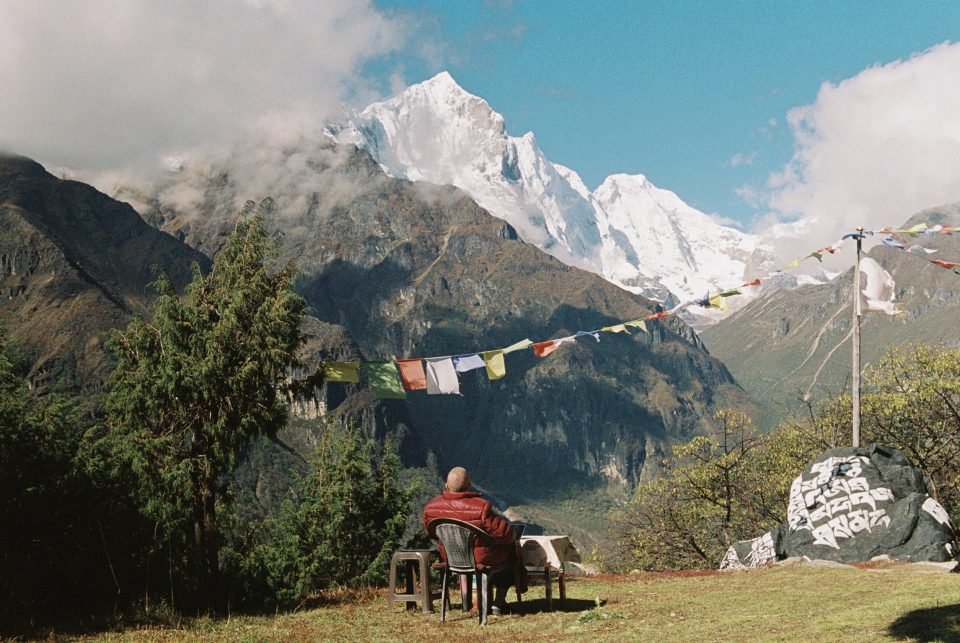
Ven. Robina set up her usual “office” overlooking the valley at the edge of the lawn in front of the Lawudo gompa where the internet connection is best.
Photo by Jacque Rabie.
Amber said that he felt “lucky to walk hand-in-hand with Ven. Robina. And we had blue sky when we hoped for it.” Reflecting on the journey later he said, “For me, it was yet another experience of a lifetime to travel with such an admirable person. With all that happened, and particularly because of walking with Ven. Robina, it makes me think this was the best trek yet. I can’t imagine any other trip better than this!”
Finally at Lawudo’s gate, Ven. Robina was greeted by Ani Samten-la. It was moving to see them reunited again after three years.
Ven Tsültrim, a Swiss nun who is staying at Lawudo for six months, accompanied Ven. Robina and Amber through the open gate that Ven. Katy was holding while the rest of us cheered. Finally we were all together.
Ven. Robina gave us teachings in the gompa every morning, afternoon and evening. To receive teachings in such a blessed place is pretty special. But it wouldn’t be until our third day that the clouds finally lifted to reveal the splendor of the surrounding mountains. It was easy to imagine why Rinpoche’s previous incarnation, the yogi Kunsang Yeshe, would have chosen such a place to meditate. For Viva, it was “a thrill to see the mountains for the first time when the mist finally lifted.”

View from the walk from Mende to Lawudo. Photo by Jacque Rabie.
In between teachings, people involved themselves in different tasks around the hermitage and went on short hikes to explore the area. Georges inspired others to join him during morning yoga sessions on the gompa lawn. One afternoon, Ven. Tsültrim showed Yannai, Manuela, Geraldine, and Katharina how to do water bowl offerings Sherpa-style. Mark and Toni cleaned the Lawudo house windows. Many of us visited Lama Kunsang Yeshe’s stupa behind the property and walked to the ridge of the mountain. Dom and Jacque walked to Charok, another hermitage and the birthplace of Charok Lama, a contemporary of the Lawudo Lama, on the same side of the mountain. They were lucky to meet Charok Ani-la who lives there and is often on long-term retreat. She served them warm orange juice, a local drink that we were also served upon arrival at Lawudo. Not many words were exchanged because of the language barrier. But she pointed to a photo and said in English, “It is Charok Lama… My father,” and smiled. After sitting with her in silence for a while after finishing their drinks, they made offerings, and said goodbye.
Ani Samten-la is the mother of Lawudo. She has lived there for over fifty years. Wearing worn-out robes, an apron, a saffron-colored fleece beanie and an old pair of pink and black Sketchers, she’s such a presence. She patiently posed for photos with a new pair of shoes that Rinpoche had sent with us to offer her. One morning before our teachings, Ani Samten-la came to sit in the sun shining on the gompa steps. A small group formed around her as she told stories of her childhood with Rinpoche (she is about six years older), and stories of the gompa construction and her experiences over the years. She captivated us with her special way of storytelling and her laughter. At one point while talking about herself she said, “No merit. Nothing. Just eating, sleeping… Nothing. Just eating and sleeping.” “Like Shantideva,” Ven. Tsültrim cut in. We all knew that Ani Samten-la has never stopped working and taking care of everyone who enters the Lawudo gate.
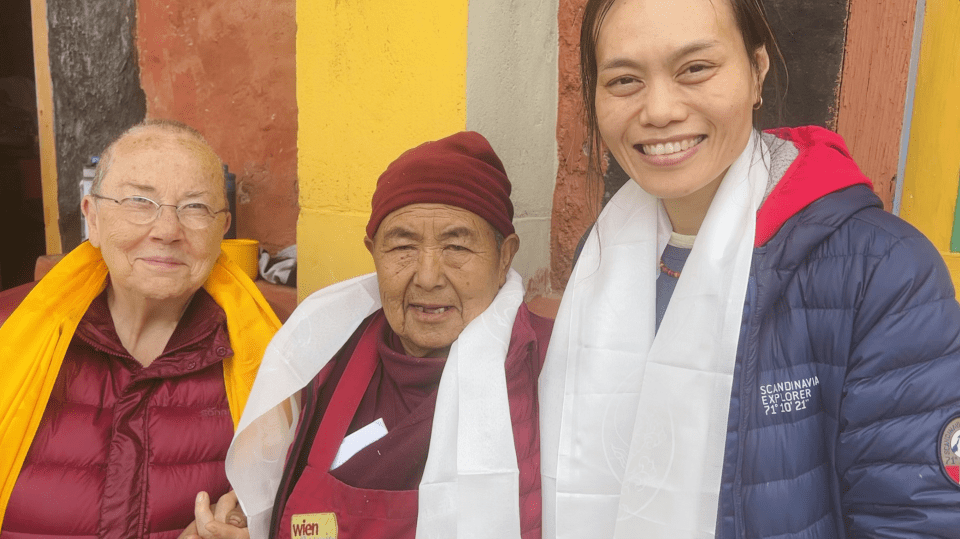
Ven. Robina Courtin, Ani Ngawang Samten, and Lawudo Trek organizer, Kristina Mah.
Lawudo feels like a place trapped in time. There has been running water there since only 2019. There are many daily tasks and always something to do. Yet, on another level, it is a place that feels separate from the mundane. These mountains have been blessed by the presence of great meditators and holy beings for centuries and it’s said that Solu Khumbu is a sacred hidden valley, a beyul, blessed by Padmasambhava (Guru Rinpoche) that offers refuge in times of great strife or trouble.
People feel this special quality. “After a rollercoaster of emotional ups and downs and uncertainty about being able to attend the trek, it was an extraordinary privilege to be allowed access into this beyul,” Julian said. “Observing this very different way of life in the monastery at such an altitude was eye-opening and life-affirming.” Anna was returning to Lawudo after her first visit five years ago. “I realized everything was there. It was possible. Achievable. Enlightenment.”
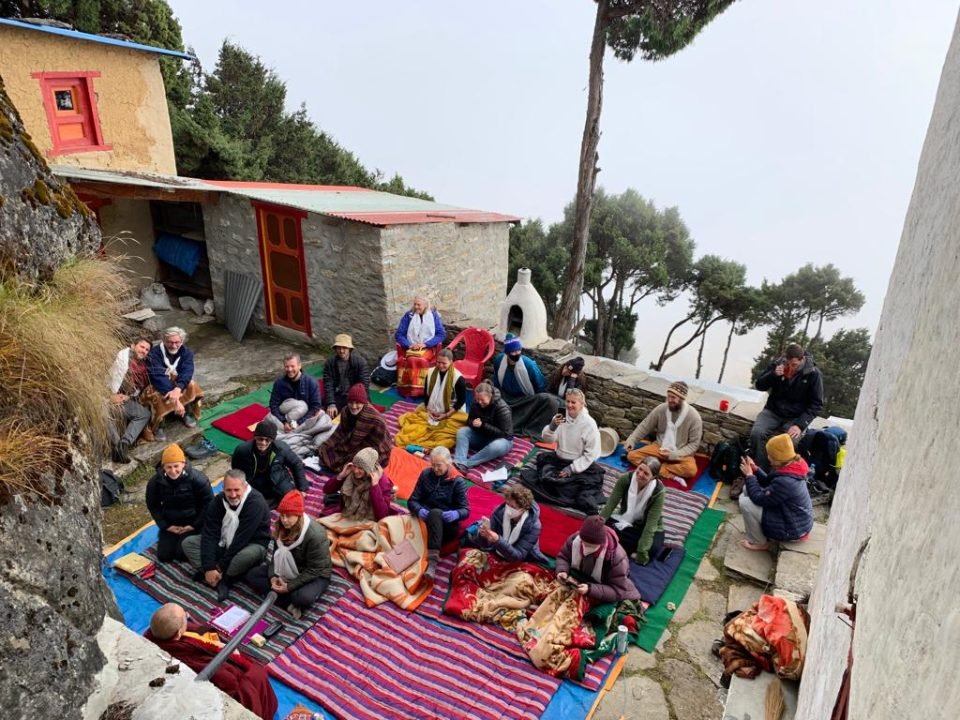
Ven. Robina offering teachings in front of the cave on the last day of the retreat. Photo by Ven. Katy Cole.
On our last day, we had teachings in front of Rinpoche’s cave. Many of us felt that the end of our retreat had come too soon. Our time there was so precious, especially after the two-year delay and the effort we had to expend to get there. “So thankful to the holy beings who enabled our group to overcome all obstacles to our pilgrimage,” said Viva.
As we got ready to part ways and farewell Ani Samten-la and the Lawudo community along with three of our trekkers, Georges assured us confidently, “We have met before, and we will meet again!”
We split up again into small groups for the journey back to Kathmandu. By the end of the trek, Jacque had cut through his fear of helicopters and happily volunteered to catch one to Kathmandu from Lukla. Thankfully, Dawn was feeling much better by the time Ven. Robina arrived back at Namche in her helicopter to pick her up. Ani Samten-la sent her a blessing scarf and chocolate.
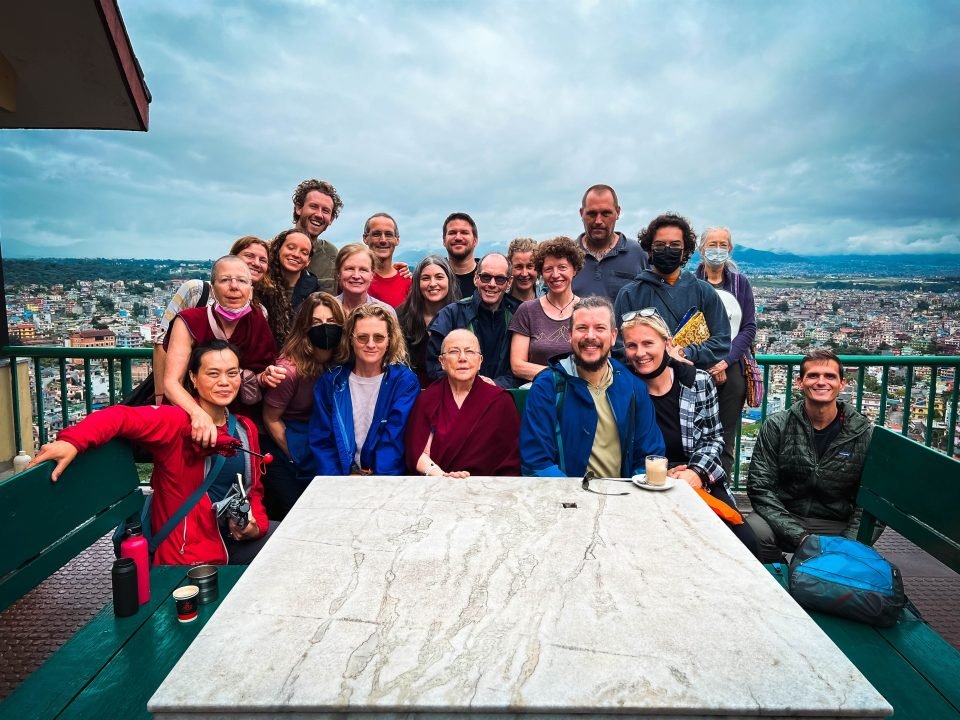
Lawudo trekkers, October 2022. Photo shared by Kristina Mah.
Ven. Robina often speaks of the bond that people form and feel when they go on pilgrimage together. Perhaps the bond forms while greeting obstacles and going through “magical moments” along the journey that forge a mini community created from around the world. “It was amazing to see how the group grew closer day by day and friendships were made so quickly,” said Julian. “The trek is such a rare opportunity,” said Mark. “I was so glad to have met so many kind and genuine people and share our journey together.” “It felt like a true pilgrimage with many highs and challenges that we took in stride,” said Aidan. For Jacque, his time in Nepal after discovering Ven. Robina on TikTok a month earlier, was “truly, a life-changing experience.”
We gathered for a final practice together at the ancient Boudha Stupa, not far from downtown Kathmandu. Before we started our circumambulations, Ven. Robina led us in dedicating all the merits of our amazing journey and refreshed our aspiration to have the courage to always do what is most beneficial and to never give up. It’s a sentiment that resonates with us after this trek and Dom captured it beautifully. “The Lawudo Trek was a trip of a lifetime. Not only because of the people we met but the magical moments along the way,” he said.
Amber said, “This was the best trek ever,” despite all obstacles and changes of plan. When Ven. Robina heard this, she said, “Isn’t that interesting. I trust Amber’s wisdom.”
The Lawudo Trek offers $500 to Lawudo for each participant, half for Lama Zopa Rinpoche’s planned replica of Guru Rinpoche’s Pure Land, Zangdok Palri, Glorious Copper-Colored Mountain, and the other half for maintenance and development. This year the trek raised US$17,000, from contributions from trekkers as well as benefactors. The total raised and offered since 2017 is US$91,000.
- Tagged: lawudo, lawudo retreat centre, pilgrimage, ven. robina courtin
- Home
- News/Media
- Study & Practice
- About FPMT Education Services
- Latest News
- Programs
- New to Buddhism?
- Buddhist Mind Science: Activating Your Potential
- Heart Advice for Death and Dying
- Discovering Buddhism
- Living in the Path
- Exploring Buddhism
- FPMT Basic Program
- FPMT Masters Program
- FPMT In-Depth Meditation Training
- Maitripa College
- Lotsawa Rinchen Zangpo Translator Program
- Universal Education for Compassion & Wisdom
- Online Learning Center
- Prayers & Practice Materials
- Overview of Prayers & Practices
- Full Catalogue of Prayers & Practice Materials
- Explore Popular Topics
- Benefiting Animals
- Chenrezig Resources
- Death & Dying Resources
- Lama Chopa (Guru Puja)
- Lama Zopa Rinpoche: Compendium of Precious Instructions
- Lama Zopa Rinpoche: Life Practice Advice
- Lama Zopa Rinpoche Practice Series
- Lamrim Resources
- Mantras
- Prayer Book Updates
- Purification Practices
- Sutras
- Thought Transformation (Lojong)
- Audio Materials
- Dharma Dates – Tibetan Calendar
- Translation Services
- Publishing Services
- Teachings and Advice
- Find Teachings and Advice
- Lama Zopa Rinpoche Advice Page
- Lama Zopa Rinpoche: Compendium of Precious Instructions
- Lama Zopa Rinpoche Video Teachings
- ༧སྐྱབས་རྗེ་བཟོད་པ་རིན་པོ་ཆེ་མཆོག་ནས་སྩལ་བའི་བཀའ་སློབ་བརྙན་འཕྲིན།
- Podcasts
- Lama Yeshe Wisdom Archive
- Buddhism FAQ
- Dharma for Young People
- Resources on Holy Objects
- Ways to Offer Support
- Centers
- Affiliates Area
- Teachers
- Projects
- Charitable Projects
- Make a Donation
- Applying for Grants
- News about Projects
- Other Projects within FPMT
- Support International Office
- Projects Photo Galleries
- Give Where Most Needed
- FPMT
- Shop
Translate*
*powered by Google TranslateTranslation of pages on fpmt.org is performed by Google Translate, a third party service which FPMT has no control over. The service provides automated computer translations that are only an approximation of the websites' original content. The translations should not be considered exact and only used as a rough guide.Cherishing others opens the door to every happiness for self and others.







